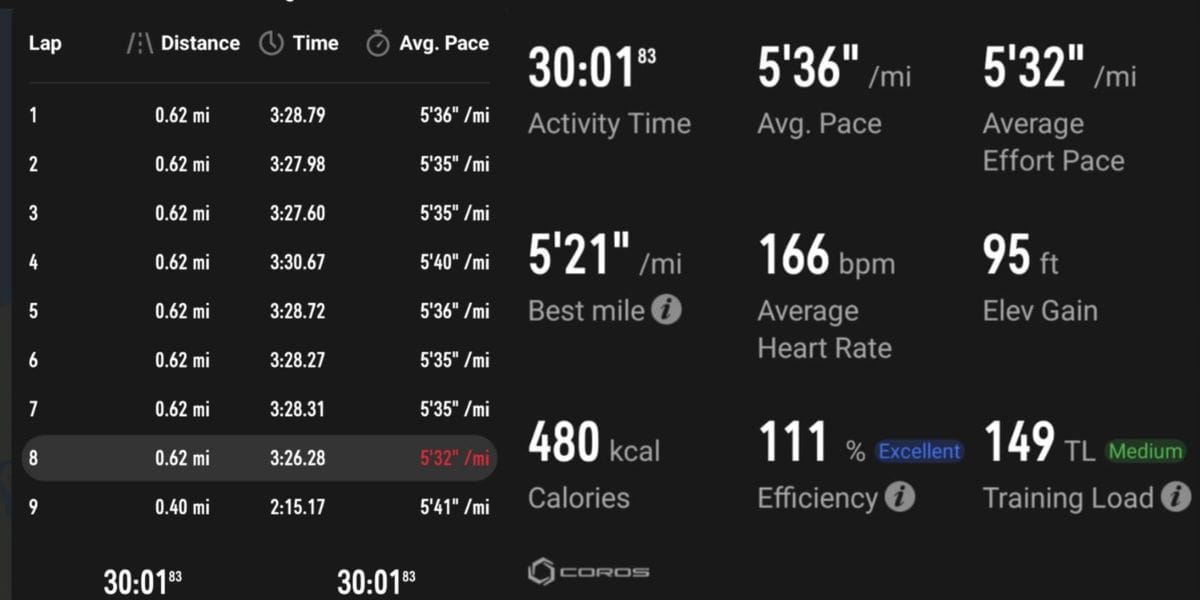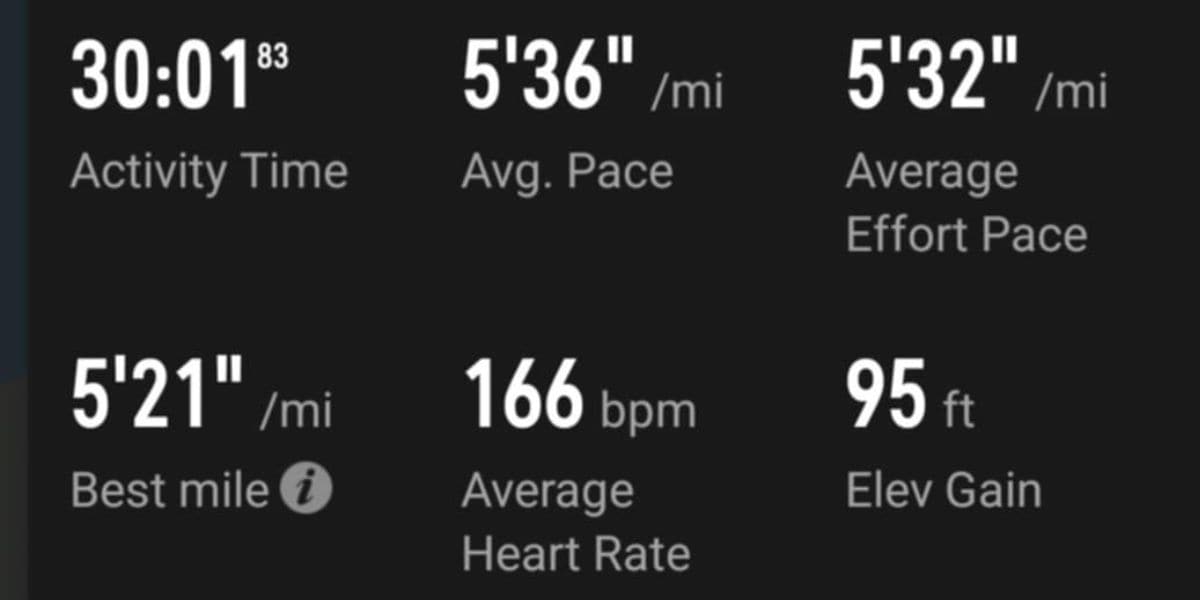Are you stuck at a plateau in your training, or have you heard of tempo running but not known where to start? If that's you, then check out the below.
This type of training is used by elite runners all over the world - myself included as I've used tempo runs to help achieve my 31:10 10k PB and in coaching runners to their personal bests.
If this is your first time doing tempo runs, prepare yourself for a big boost in performance.
What is a tempo run?

A tempo run is sustained running at a "comfortably hard" pace. It's the pace you could theoretically hold for about an hour in a race, though you'd be pretty uncomfortable by the end.
Here's how I explain it to the runners I coach: during a tempo run, you should only be able to speak out 2-3 words at a time. Not full sentences like an easy run, but you're not gasping for air either. It's that sweet spot where you're working hard but still in control.
The goal of tempo runs is to improve your lactate threshold. When I was chasing my 31-minute 10k goal, tempo runs were absolutely crucial for teaching my body to clear lactate efficiently at faster paces.
Why tempo runs work (the science made simple)
As an elite athlete, I've learned that understanding the "why" behind training makes you execute it better. Here's what's happening in your body during tempo runs:
Your lactate threshold is like a metabolic ceiling. Below it, you feel strong and controlled. Above it, you start burning up fast. Tempo runs train right at that ceiling, gradually raising it higher.
Think of it this way - when I was running 32-minute 10ks, my threshold was lower. Through consistent tempo work, I raised that ceiling, allowing me to sustain faster paces longer. That's how I eventually ran 31 minutes.
The physiological adaptations include:
- Better lactate clearance - your body becomes more efficient at processing waste products
- Improved oxygen delivery - your cardiovascular system adapts to meet demands at higher intensities
- Enhanced running economy - you waste less energy maintaining faster paces
How to find YOUR tempo pace
This is where I see many runners go wrong. They either run tempo too hard (turning it into a time trial) or too easy (missing the training benefit). Here are the methods I use with my athletes:
Method 1: Recent race times (Current ability)
- 25-30 seconds per mile slower than 5k pace
- 10-15 seconds per mile slower than 10k pace
- Current half marathon race pace
- The pace you could hold for 50-60 minutes if you were racing and well rested
For example, when I was running 5:02 mile pace for 10k, my tempo pace was around 5:15 per mile.
Method 2: Heart rate (if you know your zones)
I like to use heart rate zones in my training and particularly for tempo runs.

- 85-90% of maximum heart rate for most athletes
- 80-85% if you're newer to structured training
Method 3: Effort-based (my favorite for beginners)
I tell my athletes: start at 6/10 effort, finish at 8/10. You should feel like you could continue for another 10-15 minutes after finishing. If you're struggling at the end, you went too hard.
Pro tip from my coaching experience:
Do a 3-5k time trial every 6-8 weeks to recalibrate your paces as you get fitter. Your tempo pace should get faster as your fitness improves - that's the whole point!
Reasons you need to add a tempo run into your training program
From my years of elite competition and coaching, here are the key benefits I've observed:
Improve Running Efficiency
Tempo runs teach your body to waste less energy at faster paces. When I analyze my athletes' data, I consistently see improved efficiency metrics after 6-8 weeks of consistent tempo work.
Build Mental Toughness
This might be the most underrated benefit. Tempo runs hurt in a specific way - they require sustained focus and the ability to push through accumulating discomfort. This mental training is invaluable on race day.
Enhance Endurance
The sustained nature of tempo runs directly improves your ability to maintain challenging paces over longer distances. This is especially crucial for half marathon and marathon runners.
Increase Lactate Threshold
The primary adaptation - and why tempo runs are so effective. Every elite distance runner I know does some form of threshold training.
Mimic Race Conditions
Tempo runs simulate the sustained discomfort of racing. The more you practice managing this feeling in training, the better you'll handle it when it matters.
Prevent Plateaus
When easy running alone stops producing gains, tempo runs provide the stimulus needed for continued improvement. I've seen this breakthrough happen countless times with my athletes.
Build Confidence
There's something powerful about successfully completing a challenging tempo run. It proves to yourself that you can sustain uncomfortable paces - crucial mental preparation for racing.
How to execute a tempo run like an elite athlete

Here's my step-by-step process, refined through years of elite training and coaching:
Step 1 - Choose your metric
For most runners: Use pace as your primary guide, but pay attention to effort
For experienced athletes: Combine pace + heart rate data
For beginners: Focus on effort first, then add metrics as you develop
I always tell my athletes: if you have to choose between hitting exact pace and maintaining the right effort, choose effort.
Some days your legs feel heavy, some days you feel like flying. The effort should be consistent.
Step 2 - Your equipment
Here are some of the equipment you may decide to use for your tempo run, you certainly don't have to have it or high end versions, but it can make the tempo workout easier to control.
- GPS watch - For pacing feedback, I set my Coros watch on to lap splits, for each mile.
- Heart rate monitor - chest or arm strap preferred for accuracy
- Race-day shoes if you're preparing for a specific event
- Weather-appropriate gear that won't restrict movement
Step 3 - The workout structure
Warm-up (15-20 minutes):
- 10 minutes easy jogging
- Dynamic movements: leg swings, high knees, butt kicks
- 3-4 progressive accelerations to tempo pace
This warm-up is non-negotiable. I see too many runners skip it and either get injured or have poor workout quality.
Main set:
Start conservatively! Begin at the easier end of your tempo range and settle into rhythm over the first 2-3 minutes. Don't worry about the first mile being slightly slow - better to finish strong. Either complete your tempo run based on distance or time.
Cool-down (10-15 minutes):Easy jogging followed by stretching. This isn't optional - it starts your recovery process.
Step 4 - During the run
- Monitor your splits but don't become a slave to your watch
- Focus on smooth, efficient form - relaxed shoulders, quick turnover
- Practice race strategies - hydration, fueling, mental techniques
- Stay patient - resist the urge to surge or "test yourself"
Step 5 - Post-run analysis
I have all my athletes review their sessions:
- Pacing consistency - were your splits relatively even?
- Subjective effort - did it feel appropriately challenging?
- Heart rate response - was it in your target zone?
- Form breakdown - any areas that felt inefficient?
This review process is how you learn to execute tempo runs perfectly.
3 tempo workouts I use with my athletes

Beginner: Cruise Intervals
Perfect for: New to tempo running or building back from time off
Workout:
- 15-minute warm-up
- 4 x 8 minutes at tempo effort with 2 minutes easy recovery
- 15-minute cool-down
Why it works: The breaks make the workout psychologically easier while preserving the physiological benefits.
Intermediate: Classic Sustained Tempo
Perfect for: Half marathon and marathon training
Workout:
- 15-minute warm-up
- 25-40 minutes continuous at tempo pace
- 15-minute cool-down
Progression: Start at 25 minutes, add 5 minutes every 2-3 weeks up to 40 minutes.
Advanced: Marathon-Specific Progression
Perfect for: Experienced marathoners in peak training
Workout:
- 15-minute warm-up
- 20 minutes at tempo pace
- 15 minutes at easy pace (stay relaxed!)
- 15 minutes at tempo pace
- 15-minute cool-down
Purpose: Teaches you to run fast on tired legs - crucial for marathon success.
Common mistakes I see runners make
1. Running tempo runs too fast
The #1 error. If you're running so hard that you couldn't continue for another 15 minutes, you're defeating the purpose. Tempo should feel controlled.
2. Inconsistent pacing
Starting too fast, then fading. Or surging throughout the run. Aim for negative or even splits - this requires discipline but produces better adaptations.
3. Poor recovery
Tempo runs are demanding. I schedule easy days before and after for all my athletes. Recovery is important to adapt and really benefit from your workout.
4. Wrong terrain for the workout
If your tempo pace was calculated from a flat 10k, don't run it on hills. Save hilly tempo runs for when you're using effort/heart rate as your guide.
5. Skipping the warm-up
I cannot stress this enough - jumping into tempo pace cold is asking for injury and poor workout quality.
Taking it to the next level
For serious competitive runners, consider:
Lactate threshold testing: I recommend this for any runner serious about performance. Get tested every 6 months to dial in your training zones precisely.
Environmental specificity: If your goal race is hot, humid, or at altitude, practice some tempo runs in those conditions.
Fueling practice: For half marathon and marathon runners, tempo runs are perfect for practicing race-day nutrition strategies.
My experience with tempo runs

As both an elite athlete and coach, I can tell you that tempo runs are fundamental for distance running success.
I've watched dozens of my athletes break through plateaus using strategic tempo training. The key is consistency, proper execution, and patience with the process.
Make sure you include tempo runs in your training plan. From building endurance and increasing speed to improving mental toughness, they're essential for any runner looking to take their performance to the next level.
The confidence and mental strength you build from regularly completing challenging tempo runs translates directly to better racing. When you've practiced sustaining discomfort in training, race-day suffering becomes manageable.
FAQ
Is a tempo run faster than a jog?
Yes a jog is easy, conversational pace. Tempo is significantly harder - that "comfortably hard" effort. The difference in pace will vary by runner, but expect tempo to be 1-2 minutes per mile faster than your easy pace.
What is a tempo run for beginners?
Start with cruise intervals: 10-minute warm-up, 3 x 5 minutes at tempo effort with 90 seconds recovery, 10-minute cool-down. Progress to longer intervals before attempting sustained tempo runs.
How often should I do tempo runs?
Once per week for most runners. Advanced marathoners might do two per week during peak training, but never on consecutive days. I'm very strict about this with my athletes.
Can I do tempo runs on a treadmill?
Yes! Treadmills are actually great for tempo work - consistent pacing and controlled environment. Just make sure you're familiar with the machine and start conservatively.
